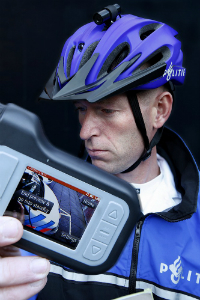How to choose the right body-worn camera for your needs.
The wide choice of cameras available on the market might make choosing the right one confusing. “The customer should first know what their requirements are. For example, how many hours of recording are needed, how they want to wear the camera (i.e., chest only or also helmet or shoulder), do they need live streaming or just recording, a simple one-size fits all system versus a modular system that allows for customization (e.g., connect external cameras), security features such as encryption or different authorization levels, what VMS system to use, etc.,” explained Bart van der Aa, CEO of Netherlands-based Zepcam. Most bodycams have similar specs.
Most come with pre-event recording and start recording after the user pushes a button. Other common features are tagging videos (to enable fast retrieval), enabling watching of the footage on other devices (e.g., police car, command center, tablet, etc.). Another offer is streaming video via 3G/4G to increase situational awareness at the command and control level. “We believe the (near) future in this industry is in a combination of recording and live streaming,” said van der Aa.
 Image suurce Zepcam
Image suurce Zepcam
Since the bodycam footage can be used as evidence during court trials, companies have to make sure that their products adhere to the different regulations regarding maintaining the integrity of digital evidence. There are several common features to ensure data integrity. Different authorization levels ensure that the police officer wearing the camera has no way of tampering with the video, deleting it, or changing it.
“In Zepcam for example, we have three authorization levels: user level (allows just recording and live streaming, but no file deletion or access to recorded files), super user (which allows recording and live streaming, as well as the ability to delete files and access recorded files), and administrator level, which adds system administration privileges on top of the super-user level,” explained van der Aa.
Reveal offers encryption of the videos as they are uploaded to the video management system. Files can be viewed only on authorized computers and only by users with the appropriate password to unlock the encryption. The system keeps a comprehensive audit log of every action and event performed on files in the system from the point at which it was uploaded and throughout its lifetime. The audit log records the date/time of the action, the user who performed it, the computer where the action was performed, and the description of the action itself. An additional feature offers the ability to “cloak” files, which may be used when sensitive material has been uploaded. Cloaked files can only be viewed by user levels as defined by the administrator. This helps to further secure information even within the police department.
Cloud or local storage
Footage is usually stored on the device and then uploaded from the docking station at the end of the shift — the docking station also charges the camera for the next shift. For most manufacturer models, end users can choose between local storage and cloud storage. Despite the availability of the option, our interviewees agreed that most law enforcement agencies are uncomfortable with storing their solution in the cloud. “The majority of our customers use local storage over cloud,” said Jo McLean, VP for International Marketing at Reveal. The advantage of cloud storage is that files are accessible from any location with Internet; however, this can be seen as a disadvantage by some in terms of data security.
“Some countries are not comfortable with their data being held in off-shore data centers and have specific policies that do not permit this. There is a misconception that local storage can demand significantly more attention and maintenance than cloud when generating large volumes of video data,” McLean added.
“Cloud storage can work when it is a private cloud, hosted in the domain of the client. Security is very important. Governments (and many others) usually do not trust third-party hosted cloud services and do not allow storing their police/national security data on a third-party server,” said van der Aa.
Vizucop’s Barnes added an additional concern: what happens to the data after the initial contract ends? “Let’s say you have a three-year contract and you manage to find a cheaper provider when it ends. Will agencies actually be able to move their stored information?”
Industry shakeout is imminent
The sharp rise in interest in bodycams and the available funds have brought a lot of models to the market. Buyers should be aware and make sure they buy from reputable manufacturers that can offer proper support.
“You need to look at durability of the camera, is the company well established or is it from someone who found a cheap source overseas in which case there is no support. Customer service is big in this industry, law enforcement agencies require fast response times. So the cheap camera sellers will be shaken out, the costs of after-sales service will weed out the smaller players,” said Barnes.